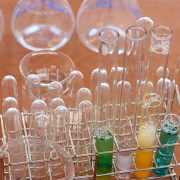Jenis-Jenis dan Fungsi Spatula Laboratorium Yang Wajib Anda Ketahui
Fungsi spatula laboratorium sangatlah penting, terutama bagi Anda yang bekerja di dunia penelitian. Namun, sebelum membahas lebih dalam tentang fungsi-fungsi spatula laboratorium, terlebih dahulu ketahui definisinya. Secara umum, spatula adalah alat untuk mengambil sebuah objek.
Ada banyak jenis spatula, baik yang digunakan untuk penelitian di laboratorium maupun untuk kegiatan memasak. Nah, khusus untuk spatula laboratorium kimia maupun biologi, bentuknya kecil, pipih, dan bertangkai. Untuk lebih jelasnya, berikut ini uraian lengkap mengenai jenis-jenis sekaligus fungsi spatula laboratorium tersebut.
Bahan dan Bentuk Spatula Laboratorium
Ada banyak bahan yang bisa digunakan untuk membuat spatula, mulai dari bahan kayu, alumunium, hingga stainless steel. Pemilihan bahan ini pastinya sangat berhubungan dengan benda apa yang akan diambil dengan spatula tersebut. Jika benda yang diambil berisiko mengalami reaksi jika berhubungan alumunium, pastinya bahan spatula yang digunakan sebaiknya dari kayu atau stainless steel.
Selain bahan, bentuk spatula laboratorium sangat bergantung pada besarnya benda yang akan diambil. Sebagai contoh, spatula yang digunakan untuk mengambil sampel yang hanya mempunyai berat sekitar 5 gram, pastinya berbeda dengan bentuk spatula yang akan digunakan untuk mengambil sampel berukuran hingga 30 gram atau bahkan lebih.
Jenis-Jenis Spatula Laboratorium
Secara garis besar, ada tiga jenis spatula yang biasa digunakan untuk keperluan laboratorium. Berikut ini ulasan lebih lengkapnya:
- Alat Spatula yang terbuat dari bahan stainless steel.
- Spatula politena atau spatula tanduk.
- Spatula nikel, yaitu spatula yang disepuh dengan menggunakan bahan nikel.
Fungsi Spatula Laboratorium
Dari ketiga jenis spatula laboratorium di atas, masing-masing mempunyai fungsi yang berbeda. Berikut ini lebih lengkapnya tentang fungsi spatula laboratorium berdasarkan jenis-jenisnya:
1. Spatula Stainless Steel
Spatula yang terbuat dari bahan yang diyakini anti karat ini biasanya digunakan untuk mengambil objek sangat kecil yang telah melalui proses pengirisan dan disiapkan untuk bahan penelitian melalui mikroskop.
2. Spatula Politena
Spatula yang juga sering disebut banyak orang spatula tanduk ini biasanya digunakan untuk mengambil bahan-bahan kimia dalam bentuk padat.
3. Spatula Nikel
Spatula ini berfungsi sebagai sendok kecil yang juga digunakan untuk mengambil bahan kimia. Hanya saja bedanya, alat ini juga bisa digunakan sebagai alat pengaduk saat membuat suatu larutan. Semua jenis larutan yang ingin dibuat, kecuali larutan asam, bisa menggunakan alat ini sebagai alat pengaduk. Meskipun merupakan hasil sepuhan nekel, namun pada dasarnya spatula ini berasal dari sebatang kaca yang mempunyai diameter 4 mm.
Batang kaca tersebut kemudian dipotong memanjang dan di kedua ujungnya dibuat membulat dengan menggunakan nyala bunsen. Untuk ukuran panjang, spatula digunakan untuk tabung reaksi biasanya mempunyai panjang 20 cm, sedangkan spatula yang digunakan pinggan atau gelas piala kecil biasanya mempunyai panjang 8–10 cm.
Itulah pembahasan mengenai pengertian, bahan, jenis-jenis, sekaligus fungsi spatula laboratorium. Bagi pekerja laboratorium, baik kimia maupun biologi, informasi ini sangatlah penting, mengingat dalam setiap percobaan, bahan kimia tidak sembarang bisa berinteraksi dengan semua bahan, termasuk bahan dari medianya.
Salah dalam menggunakan jenis spatula akan berakibat fatal pada hasil penelitian yang sedang dilakukan. Dengan kata lain, meskipun kecil, benda ini ternyata sangat penting perannya dalam dunia penelitian. Oleh karena itu, mengetahui tentang jenis-jenis sekaligus fungsi spatula laboratorium sangat penting untuk diketahui.






 WhatsApp us Now
WhatsApp us Now